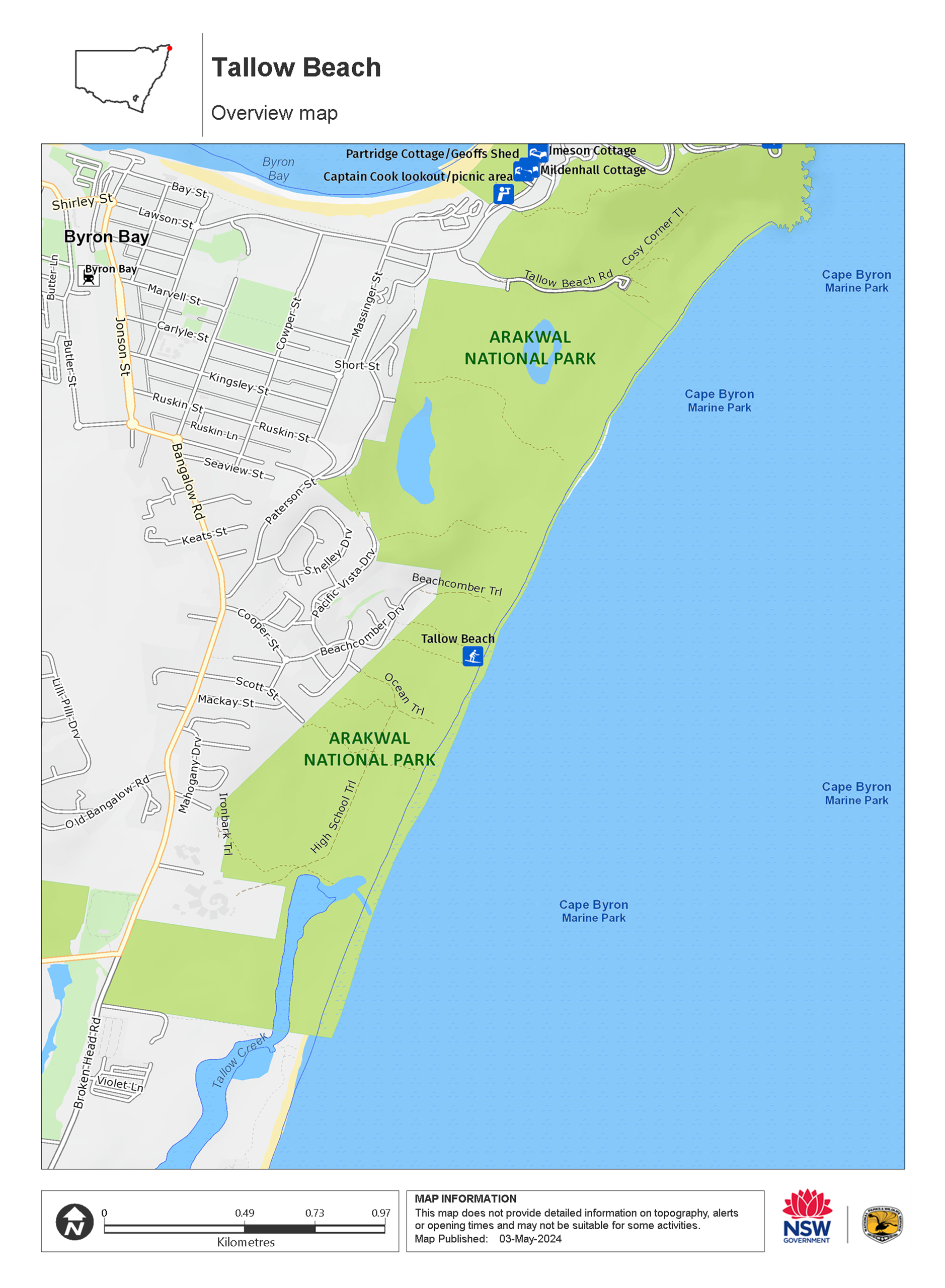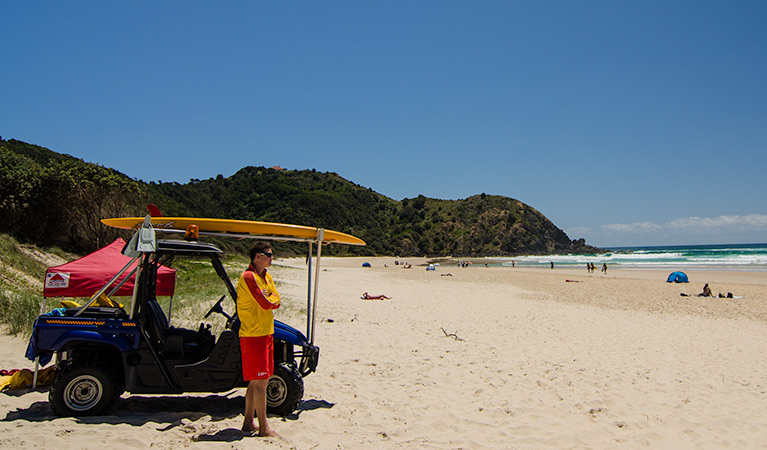Tallow Beach
Arakwal National Park
Overview
Tallow Beach is 3.2km from the heart of Byron Bay and a great place for swimming, birdwatching, whale watching, beach fishing, and just throwing down a towel to soak up the sun.
- Where
- Arakwal National Park in North Coast
- What to
bring - Drinking water, hat, sunscreen
- Please note
- Check the tide before you set out as this may affect your beach walking
- The weather in this area can be extreme and unpredictable, so please ensure you’re well-prepared for your visit.
A scenic bridge between Cape Byron State Conservation Area and Broken Head Nature Reserve, Tallow Beach offers a terrific place to throw down a towel and soak up the sun. You could pull out binoculars for an afternoon of whale watching in spring and winter though, as whales migrate between the Great Barrier Reef and Antarctica.
Just 3.2km from the heart of Byron Bay, Tallow Beach is alive with osprey and white-bellied sea eagles scouring the coast in search of food. As you relax on the sand, pied oystercatchers wander past searching for pippis. Avid birdwatchers will find more to see behind the dunes adjacent to residential areas, where many paper bark trees provide plenty of hiding holes for our feathered friends.
Beach fishing is possible here, as well as surfing in the right tide. For swimming and surfing, please be aware of rip tides and keep an eye on children – Tallow Beach is unpatrolled. It is, nevertheless, very popular in summer, the school holidays and Easter, so arrive early for the best spot.
Map

Map legend

Local alerts
For the latest updates on fires, closures and other alerts in this area, see https://www.nationalparks.nsw.gov.au/things-to-do/surfing-spots/tallow-beach-activity/local-alerts
General enquiries
- National Parks Contact Centre
- 7am to 7pm daily
- 1300 072 757 (13000 PARKS) for the cost of a local call within Australia excluding mobiles
- parks.info@environment.nsw.gov.au
Park info
- in Arakwal National Park in the North Coast region
Arakwal National Park is always open but may be closed at times due to storm weather or fire danger.
Visitor info
All the practical information you need to know about Tallow Beach.
Maps and downloads
Learn more
Tallow Beach is in Arakwal National Park. Here are just some of the reasons why this park is special:
Animals on the move

Arakwal may be small from the outside, but its borders hold some important habitat for threatened plant species like the creatively-named stinking crypotocarya, and dark greenhood. Keen nature enthusiasts will find much of interest; bring the magnifying glass, but be careful not to damage what you see. The reserve is also a temporary home to a range of nomadic and migratory animals, which means it's never quite the same in any given season. During autumn and winter, for example, the growing, flowering and fruiting season attracts birds, flying foxes and micro bats. Then there are the humpback whales, drifting past out to sea as they cycle annually between Queensland and the freezing waters of the Antarctic.
This is Aboriginal land

The reserve falls within the custodial boundaries of Bundjalung nation, with prime importance for the local Arakwal People who lend their name to the national park. The Bundjalung of Byron Bay (Arakwal) Peoples' connection to the reserve was recognised in 2001, with the signing of an Indigenous Land Use Agreement between the Bundjalung of Byron Bay (Arakwal) People and the NSW State Government.
Plants and animals protected in this park
Animals
-

White-bellied sea eagle (Haliaeetus leucogaster)
White-bellied sea eagles can be easily identified by their white tail and dark grey wings. These raptors are often spotted cruising the coastal breezes throughout Australia, and make for some scenic bird watching. Powerful Australian birds of prey, they are known to mate for life, and return each year to the same nest to breed.
-

Superb fairy wren (Malurus cyaneus)
The striking blue and black plumage of the adult male superb fairy wren makes for colourful bird watching across south-eastern Australia. The sociable superb fairy wrens, or blue wrens, are Australian birds living in groups consisting of a dominant male, mouse-brown female ‘jenny wrens’ and several tawny-brown juveniles.
-

Koala (Phascolarctos cinereus)
One of the most renowned Australian animals, the tree-dwelling marsupial koala can be found in gum tree forests and woodlands across eastern NSW, Victoria and Queensland, as well as in isolated regions in South Australia. With a vice-like grip, this perhaps most iconic but endangered Australian animal lives in tall eucalypts within a home range of several hectares.
-

Humpback whale (Megaptera novaeangliae)
The humpback whale has the longest migratory path of any mammal, travelling over 5000km from its summer feeding grounds in Antarctica to its breeding grounds in the subtropics. Its playful antics, such as body-rolling, breaching and pectoral slapping, are a spectacular sight for whale watchers in NSW national parks.

